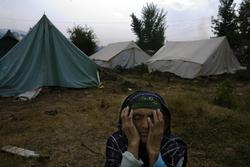 © Henk Braam
© Henk BraamIndia, Orissa. The district of Orissa was hit by an exceptionally strong cyclone. MSF dispatched a cargo plane carrying 30 metric tons of relief supplies to Bhubaneshwar, the capital of the state of Orissa. The cargo consisted of medicines, water tanks, water purification materials, plastic tarpaulins, tents, and an inflatable boat.
 © Bruno Stevens
© Bruno StevensThe international medical relief organization Médecins Sans Frontières (MSF)/Doctors Without Borders India, dispatched a specialized ten-person medical team and 40 tons of relief supplies to the Indian state of Gujarat. The team and supplies were flown directly to Ahmedebad. The medical team was there in the Kutch region of Gujarat, which was heavily hit by the earthquake.

MSF decided to focus its action in the area that had been neglected by relief operations. All aid efforts were addressed to the villages that had been already affected by the tsunami of 2004.
 © Miguel Cuenca
© Miguel CuencaIn 2004, floods caused by the monsoons were bigger than usual, causing great damage and over 2,000 deaths. In Bihar State, India, around 21 million people were affected by the floods. Darbhanga and Khagaria, 200km East of the State’s capital, Patna, were the most affected districts. MSF focused its emergency intervention in the latter, where a healthcare post was set up to offer basic medical assistance for displaced people in order to prevent the spread of epidemics. MSF team carried out 150 daily consultations on average. The project lasted from August to November 2004.






